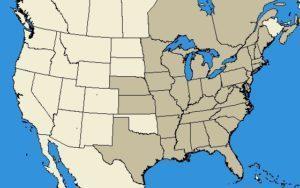The brown prionid beetle is a longhorn beetle found in the US. It is the only known species in its genus Orthosoma.
Size: 25-50 mm
Color: They have a characteristic brown body, resulting in their name.
Other Characteristic Features: Like most other long-horned beetles, the brown prionid has a long antenna, exceeding its body length.
The larva is white with brown spots on each segment and a set of brown mandibles. It eats decaying wood with fungi in it, which helps it digest the cellulose in wood. They do so for 3-5 years.
Pupation takes place in a soil chamber near the roots of the host plant.
The eggs are laid in wood (not decayed).
| Lifespan | Not recorded |
| Distribution | Common in the United States |
| Habitat | Moist decaying wood |
| Predators | Blind Click Beetle |
| Seasons active | During the warmer months of the year |
| Host plants | Fir, serviceberry, sumac, pine, oak, willow, poplar, and stone fruit |
| Diet of adults | Sap and rotting fruits |
The damage caused by this beetle is limited to the roots of trees, though it is minor most of the time.

Image Source: svtweb.org, amazonaws.com, bugguide.net
The brown prionid beetle is a longhorn beetle found in the US. It is the only known species in its genus Orthosoma.
Size: 25-50 mm
Color: They have a characteristic brown body, resulting in their name.
Other Characteristic Features: Like most other long-horned beetles, the brown prionid has a long antenna, exceeding its body length.
The larva is white with brown spots on each segment and a set of brown mandibles. It eats decaying wood with fungi in it, which helps it digest the cellulose in wood. They do so for 3-5 years.
Pupation takes place in a soil chamber near the roots of the host plant.
The eggs are laid in wood (not decayed).
| Lifespan | Not recorded |
| Distribution | Common in the United States |
| Habitat | Moist decaying wood |
| Predators | Blind Click Beetle |
| Seasons active | During the warmer months of the year |
| Host plants | Fir, serviceberry, sumac, pine, oak, willow, poplar, and stone fruit |
| Diet of adults | Sap and rotting fruits |
The damage caused by this beetle is limited to the roots of trees, though it is minor most of the time.

Image Source: svtweb.org, amazonaws.com, bugguide.net